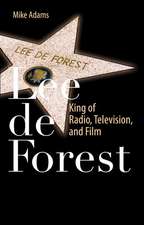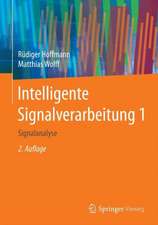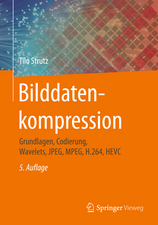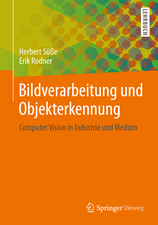Novel Motion Anchoring Strategies for Wavelet-based Highly Scalable Video Compression: Springer Theses
Autor Dominic Rüfenachten Limba Engleză Hardback – 13 apr 2018
In light of this, the present book explores the possibility of anchoring motion at reference frames instead. Key to the success of the proposed “reference-based” anchoring schemes is high quality motion inference, which is enabled by the use of a more “physical” motion representation than the traditionally employed “block” motion fields. The resulting compression system can support computationally efficient, high-quality temporal motion inference, which requires half as many coded motion fields as conventional codecs. Furthermore, “features” beyond compressibility — including high scalability, accessibility, and “intrinsic” framerate upsampling — can be seamlessly supported. These features are becoming ever more relevant as the way video is consumed continues shifting from the traditional broadcast scenario to interactive browsing of video content over heterogeneous networks.
This book is of interest to researchers and professionals working in multimedia signal processing, in particular those who are interested in next-generation video compression. Two comprehensive background chapters on scalable video compression and temporal frame interpolation make the book accessible for students and newcomers to the field.
| Toate formatele și edițiile | Preț | Express |
|---|---|---|
| Paperback (1) | 636.12 lei 43-57 zile | |
| Springer Nature Singapore – 10 ian 2019 | 636.12 lei 43-57 zile | |
| Hardback (1) | 642.18 lei 43-57 zile | |
| Springer Nature Singapore – 13 apr 2018 | 642.18 lei 43-57 zile |
Din seria Springer Theses
- 18%
 Preț: 997.88 lei
Preț: 997.88 lei -
 Preț: 389.88 lei
Preț: 389.88 lei - 15%
 Preț: 646.94 lei
Preț: 646.94 lei - 18%
 Preț: 943.43 lei
Preț: 943.43 lei -
 Preț: 399.29 lei
Preț: 399.29 lei - 18%
 Preț: 944.99 lei
Preț: 944.99 lei - 15%
 Preț: 636.80 lei
Preț: 636.80 lei - 18%
 Preț: 941.05 lei
Preț: 941.05 lei - 15%
 Preț: 643.16 lei
Preț: 643.16 lei - 15%
 Preț: 642.68 lei
Preț: 642.68 lei - 18%
 Preț: 1103.62 lei
Preț: 1103.62 lei - 20%
 Preț: 558.82 lei
Preț: 558.82 lei - 18%
 Preț: 1112.30 lei
Preț: 1112.30 lei - 18%
 Preț: 944.19 lei
Preț: 944.19 lei - 18%
 Preț: 1109.92 lei
Preț: 1109.92 lei - 18%
 Preț: 1217.27 lei
Preț: 1217.27 lei - 15%
 Preț: 640.06 lei
Preț: 640.06 lei - 15%
 Preț: 636.45 lei
Preț: 636.45 lei - 15%
 Preț: 640.06 lei
Preț: 640.06 lei - 15%
 Preț: 640.88 lei
Preț: 640.88 lei -
 Preț: 389.70 lei
Preț: 389.70 lei - 20%
 Preț: 563.89 lei
Preț: 563.89 lei -
 Preț: 393.35 lei
Preț: 393.35 lei - 15%
 Preț: 637.93 lei
Preț: 637.93 lei - 15%
 Preț: 641.85 lei
Preț: 641.85 lei - 18%
 Preț: 1225.94 lei
Preț: 1225.94 lei - 20%
 Preț: 551.36 lei
Preț: 551.36 lei - 18%
 Preț: 1229.10 lei
Preț: 1229.10 lei - 15%
 Preț: 639.25 lei
Preț: 639.25 lei - 18%
 Preț: 999.45 lei
Preț: 999.45 lei - 15%
 Preț: 640.06 lei
Preț: 640.06 lei - 18%
 Preț: 1220.45 lei
Preț: 1220.45 lei - 18%
 Preț: 1116.26 lei
Preț: 1116.26 lei - 18%
 Preț: 1110.72 lei
Preț: 1110.72 lei - 18%
 Preț: 1000.87 lei
Preț: 1000.87 lei - 18%
 Preț: 891.17 lei
Preț: 891.17 lei - 15%
 Preț: 640.06 lei
Preț: 640.06 lei - 5%
 Preț: 1154.07 lei
Preț: 1154.07 lei - 15%
 Preț: 635.96 lei
Preț: 635.96 lei - 15%
 Preț: 640.88 lei
Preț: 640.88 lei -
 Preț: 387.20 lei
Preț: 387.20 lei - 18%
 Preț: 1109.92 lei
Preț: 1109.92 lei -
 Preț: 385.25 lei
Preț: 385.25 lei -
 Preț: 385.25 lei
Preț: 385.25 lei - 18%
 Preț: 1112.30 lei
Preț: 1112.30 lei - 18%
 Preț: 999.45 lei
Preț: 999.45 lei -
 Preț: 386.99 lei
Preț: 386.99 lei - 15%
 Preț: 637.13 lei
Preț: 637.13 lei - 20%
 Preț: 554.20 lei
Preț: 554.20 lei - 20%
 Preț: 555.57 lei
Preț: 555.57 lei
Preț: 642.18 lei
Preț vechi: 755.51 lei
-15% Nou
Puncte Express: 963
Preț estimativ în valută:
122.88€ • 128.62$ • 102.28£
122.88€ • 128.62$ • 102.28£
Carte tipărită la comandă
Livrare economică 31 martie-14 aprilie
Preluare comenzi: 021 569.72.76
Specificații
ISBN-13: 9789811082245
ISBN-10: 9811082243
Pagini: 193
Ilustrații: XXIII, 182 p. 92 illus., 62 illus. in color.
Dimensiuni: 155 x 235 mm
Greutate: 0.47 kg
Ediția:1st ed. 2018
Editura: Springer Nature Singapore
Colecția Springer
Seria Springer Theses
Locul publicării:Singapore, Singapore
ISBN-10: 9811082243
Pagini: 193
Ilustrații: XXIII, 182 p. 92 illus., 62 illus. in color.
Dimensiuni: 155 x 235 mm
Greutate: 0.47 kg
Ediția:1st ed. 2018
Editura: Springer Nature Singapore
Colecția Springer
Seria Springer Theses
Locul publicării:Singapore, Singapore
Cuprins
Introduction.- Scalable Image and Video Compression.- Temporal Frame Interpolation (TFI).- Motion-Discontinuity-Aided Motion Field Operations.- Bidirectional Hierarchical Anchoring (BIHA) of Motion.- Forward-Only Hierarchical Anchoring (FOHA) of Motion.- Base-Anchored Motion (BAM).- Conclusions and Future Directions.
Notă biografică
Dominic Ruefenacht received his B.Sc. and M.Sc. in Communication Systems with a specialization in ‘Signals, Images and Interfaces’ from the École Polytechnique Fédérale de Lausanne (EPFL), Switzerland, in 2009 and 2011. He was an exchange student at the University of Waterloo, Ontario, Canada, and did his Master's thesis at Philips Consumer Lifestyle in Eindhoven, Netherlands. He obtained his Ph.D. degree from UNSW Sydney, Australia, in 2017, where he was investigating “Novel Motion Anchoring Strategies for Wavelet-based Highly Scalable Video Compression”.
From 2011 to 2013, he was with the Image and Visual Representation Group (IVRG) at EPFL as a research engineer, where he was working on computational photography problems, with emphasis on near-infrared imaging. He currently holds a post-doctoral position at UNSW Sydney, working on next-generation video compression systems. His research interests are in computational photography and highly scalable and accessible video compression, with a focus on temporal scalability.
Textul de pe ultima copertă
This thesis explores the motion anchoring strategies, which represent a fundamental change to the way motion is employed in a video compression system—from a “prediction-centric” point of view to a “physical” representation of the underlying motion of the scene. The proposed “reference-based” motion anchorings can support computationally efficient, high-quality temporal motion inference, which requires half as many coded motion fields as conventional codecs. This raises the prospect of achieving lower motion bitrates than the most advanced conventional techniques, while providing more temporally consistent and meaningful motion. The availability of temporally consistent motion can facilitate the efficient deployment of highly scalable video compression systems based on temporal lifting, where the feedback loop used in traditional codecs is replaced by a feedforward transform.The novel motion anchoring paradigm proposed in this thesis is well adapted to seamlessly supporting “features”beyond compressibility, including high scalability, accessibility, and “intrinsic” frame upsampling. These features are becoming ever more relevant as the way video is consumed continues to shift from the traditional broadcast scenario with predefined network and decoder constraints to interactive browsing of video content via heterogeneous networks.
Caracteristici
Explores motion anchoring strategies for video compression systems, which represent a shift from a “prediction-centric” point of view to a “physical” representation of the underlying motion of the scene Investigates new motion anchoring strategies that are targeted at wavelet-based highly scalable video compression (WSVC) Develops an analytical model to determine the weights of the different spatiotemporal subbands and assess the suitability and benefits of this reference-based WSVC for (highly scalable) video compression


























